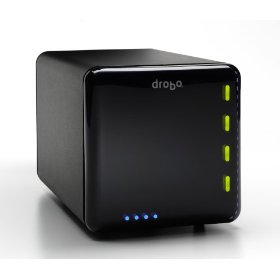 I’ll admit it, I’m a little obsessed with making sure my data is secure. My friends think I’m insane, but I’ve spent years making photographs and have ripped my 3,000 CD music collection onto my computer, so the thought of having it all vanish due to a hard drive crash or a fire is just frightening.
I’ll admit it, I’m a little obsessed with making sure my data is secure. My friends think I’m insane, but I’ve spent years making photographs and have ripped my 3,000 CD music collection onto my computer, so the thought of having it all vanish due to a hard drive crash or a fire is just frightening.
About a three years ago, I took a good look at my disaster plan, and it wasn’t very pretty. I was basically storing all my photos on a Western Digital hard drive and my music on another. Every few months I had to add another drive, so I had this huge daisy chain of hard drives tethered behind my computer. It was a complete mess.
When I started shooting events full time I realized that I had to have a proper backup system in case something horrible happened to my data. Ever a nervous Nelly, I started looking at options.
After sorting through article after article about RAID drives, DVD burning, off-site storage, and a million other “solutions,” I settled on the much hyped DROBO from Data Robotics as my main drive.
The machine is simple. It looks like a small beer cooler, but inside it has four bays that fit normal external SATA drives. You feed it as many as you want and the DROBO spreads your data redundantly over the different drives. Basically, if one drive fails you can swap it out and no data is lost. The firewire 800 connection also means that I can work directly off the DROBO without any hiccups in transfer speed. DROBO constantly lets me know what my space size is, the health of my drives, and how close I am to reaching capacity. When I swap a drive it takes about 24-hours to redistribute my data, but I can work of the system while it’s working.
It’s been up and running for about two years now and I haven’t had a single problem. However, it does have a few quirks. The power cable is a little loose and can fall out if you move the drive even a little bit. That’s not too much of a problem since I don’t drag the heavy sucker around much. It also makes you choose the size of your partition when you initialize the machine. So if you choose a smaller size of say 2 TB, like I did, you have to create a new drive on your desktop every time I fill it up with 2 TB worth of data. I’ve got 4 TB in DROBO right now and have to have two partitions. I use one for music and one for photos. It’s not a problem, but could be a nuisance if you choose a lower sized partition and chew through a lot of drive space.
Also, you have to realize that if you feed it 4 TB drives, you only get about 2.3 TB of usable drive space, because everything is duplicated for security. The initial investment is also high. The unit cost me about $400 and that’s without the drives. Luckily, you can buy the cheapest ones out there since you can always swap them out. Personally, I’m a fan of the Western Digital Caviar Green drives.
Now that’s just Stage I of my back up system. I told you I was a little insane. The extra drives I have left over from my DROBO go into a Thermaltake BlacX eSATA USB Docking Station that I use for my Apple Time Machine. The dock looks like an old Super NES and is connected via USB 2.0. I don’t really need speed for Time Machine since it just runs in the background. I use it to protect my data from accidental loss of data. For example, if my Lightrooom database gets corrupted, I can just go into Time Machine and find a version from a few days back and restore it. It works like a charm for recently corrupted or lost files.
Finally, I needed a backup solution that’s located off site. Obviously, the worse possible situation is that my place burns down and I lose everything. I used to back up everything to little WD Passport drives and move them off site once a month, but that got expensive and I’d still lose the most recent data.
After a bit of research, I stumbled on BackBlaze, a cloud back-up service that runs in the background and uploads all new data up to its server. The best part? It’s only $50 a year. New data is uploaded instantaneously and you can access it on their server any time you want. If something bad happens, you can download the data as a ZIP file or pay a fee to have it sent to you on DVDs or on a hard drive. The only problem is the initial upload. When I first signed up for the free trial I was using Verizon DSL which barely uploaded at 1MBPS. According to BackBlaze it would take me approximately 266 days to get all my data onto its server. I bit the bullet and switched to Verizon Fios and was able to get all my data to the cloud in about 15 days. Keep in mind, we’re talking about 3TB of data here. It won’t take that long with smaller batches and I’m sure cable connections are just as fast.
So there you have it. My insanely intricate, but not very complicated back up setup. I can confidently guarantee that I won’t lose a client’s data and I have the peace of mind that my music collection will never vanish. At that security is worth any cost.

![Reblog this post [with Zemanta]](https://img.zemanta.com/reblog_e.png?x-id=1c3dfe18-c25a-4a1c-a86b-bc3dfc379888)
